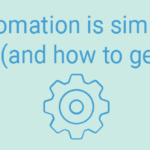Why Automation is Simpler Than You Think

Automation can seem like it’s just for huge companies or requires development skills to get started. However, it’s simpler than you think to automate your processes and radically reduce your admin workload. As a small business, automation can be your key to working less and selling more.
But what does automation really mean for your business? We can define it as using technology and data to carry out marketing and sales actions automatically.
User-friendly tools make automation easy to set up. Start by looking at your email marketing automation tool — it’s probably one of the first tools you set up as a small business and it’s the perfect testing ground for the benefits that come along with automation.
For example, email marketing automation can help you to automatically send welcome emails to new leads based on their location. Or provide tailored content depending on where the recipient is in their buying journey.
But how do you know and take action on the customer data mentioned above? By enabling your different business tools to talk to each other.
Ready to do more business with email marketing?
Start your free 60-day trial today.Two automation best practices to keep in mind:
1. Keep your business apps in sync with your email marketing tool
Companies are using an average of 7.5 business management tools, according to Bain & Company, and it’s never been easier to streamline processes by syncing all of your tools.
When your business tools are all connected, there are countless possibilities. Here are some examples:
Know your customers better
Let’s say you are collecting valuable customer information in your customer relationship management tool (CRM), but you are communicating with most of those customers with an email marketing tool. Then you should have an integration between your CRM and your email marketing tool.
For instance, if you connect Constant Contact with a CRM like Salesforce, you can enrich your email lists with the information your CRM has gathered (interests, industry, country, etc.) By doing so, you then have the capability to segment these lists according to the information your customers gave you. The result? Highly personalized communication for every contact.
Group your customers by status
What if you want to make an email marketing campaign specifically for VIP customers? You are probably using accounting tools like Xero or FreshBooks that keep track of how much a customer is spending with your product or service. In this case, you want to keep your email marketing tool in sync with your accounting tool, and make sure your VIP email list contains only those clients investing the most in your company.
With an integration in place, you remove the need for manual uploads and ensure your data is up-to-date everywhere.
For a full list of business tools that can integrate with Constant Contact, check out our Marketplace.
2. Keep your email marketing tool in sync with other tools
Now we’ve seen some of the advantages of enriching your email marketing lists with information from other business tools. But, what about the other way around? Can your other tools benefit from the information your email platform gathers?
The interaction your customers have with your emails show what they really care about. Clicks, engagement, subscriptions to newsletters, and other elements collected by your email marketing tool can be valuable information for your business.
You can easily share the data your email marketing software collects with your other business tools with an automated integration. When you have your business tools working together, you gain a 360-degree view of your contacts’ data and behavior across your company and you can better serve your customers’ needs.
Automation in action
Jeff Miller at AE Home Group, a real estate company in Maryland, uses automation to streamline his company’s marketing and personalize his communication to each individual:
“Before you could print 10,000 copies of a generic flyer with some content about your business and put it in people’s mailboxes and it worked. Now you have to segment. You have to reach individuals.”
With AE Home Group’s CRM and Constant Contact account in sync, they can segment their contacts automatically, ensuring that they’ll receive the most tailored emails from the very beginning.
Like this agency, many other small businesses are searching for ways to improve the quality of their data to boost personalization in email communications. That of course, without affecting their productivity.
Checklist: How to get started with automation
1. Build out your email subscriber list from different channels such as:
- Website sign-up forms
- Facebook Lead Ads
- Text-to-join
- Events and offline networking
2. To ensure that automation streamlines processes rather than causes new headaches, make sure your data is in tip-top shape before syncing it with new tools. That means no duplicates or out-of-date information.
3. Keep in mind your business needs. Not every business has the same goals. Therefore, not every workflow or automation will benefit you. Search for solutions you can customize.
6. Check out what your competitors and other businesses are doing. You’d be surprised with how much you can learn from them.
A scalable solution
All businesses can benefit from automating sales and marketing processes, especially when you already have so much data at your fingertips. With every email, website visit, social media engagement, or app usage, you’re getting to know your contacts better. With this data, it’s never been easier to use automation to deliver the most relevant content for them.
Ready to do more business with email marketing?
Start your free 60-day trial today.The post Why Automation is Simpler Than You Think appeared first on Constant Contact Blogs.
Contributers : Constant Contact Blogs https://conta.cc/2Y3pOh7

















No comments:
Post a Comment